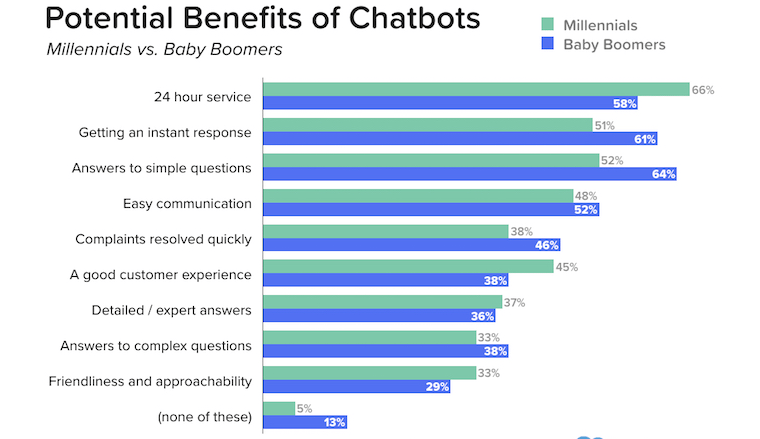REVE Chat Version 4.0
Version 4.0
Upgrade your website to an IM platform & beyond
Blending the strengths of IM and Live Chat
Upgrade your website to an instant messaging platform and beyond


What is a chatbot? How does it help to accelerate your business yield? How can you build your own chatbot?
These are some common questions that arise when you think about deploying a chatbot to your business. According to Forbes, the chatbot market is forecasted to reach $1.25 billion by 2025.
In today’s time, where customers believe that the experience a company provides is as important as its products or services. That’s where AI chatbots come in. You can pretty much say that bots are a critical part of customer service automation.
Here is a list of components that will help to understand chatbots better.
Let us comprehensively discuss how business chatbots are strengthening their place in the digital marketing strategy.
A chatbot can be defined as an AI based computer program that simulates human conversations. They are also known as digital assistants that understand human capabilities. Bots interpret the user intent, process their requests, and give prompt relevant answers.
Bots can communicate through voice as well as text and can be deployed across websites, applications, and messaging channels such as Facebook Messenger, Twitter, or WhatsApp. Together with understanding chatbots, you should also know what is AI and how it makes chatbots even more powerful.
Chatbots work by analyzing and identifying the intent of the user’s request to extract relevant entities, which is the most important task of a chatbot. Once the analysis is done appropriate response is delivered to the user.
Chatbots work by adopting three classification methods.
Bots utilize pattern matches to group the text and it produces an appropriate response from the clients. Artificial Intelligence Markup Language (AIML) is a standard structured model of these patterns. A bot is able to get the right answer in the related pattern. The bots react to anything relating to the correlated patterns.
Natural language understanding (NLU) is the ability of the chatbot to understand a human. It is the process of converting text into structured data for a machine to understand. NLU follows three specific concepts. They are: entities, context, and expectations
Natural Language Processing (NLP) bots are designed to convert the text or speech inputs of the user into structured data. The data is further used to choose a relevant answer. NLP includes important steps such as tokenization, chatbot sentiment analysis, entity recognition, and dependency parsing.
Chatbots process data to deliver quick responses to all kinds of users’ requests with pre-defined rules and AI-based chatbots. There are two types of chatbots.
Rule-based chatbots also referred to as decision-tree bots, use a series of defined rules. These rules are the basis for the types of problems the chatbot is familiar with and can deliver solutions for.
Key attributes or rule-based chatbots:
Many of us are confused over the differences between a chatbot vs conversational AI. Well, conversational chatbots combine the power of machine learning and NLP to understand the context and intent of a question before formulating a response. They are driven by chatbot scripts and generate their own answers to more complicated questions using natural-language responses. The more you use and train these bots, the more they learn and the better they operate with the user.
The conversational communication skills of the chatbot technology empower them to deliver what customers are looking for.
Key attributes of AI-enabled chatbots:
80% of marketers plan to start using a chatbot in some way or another. It is a significant reason why brands are investing in improving the customer experience.
AI-based chatbots boost operational efficiency and bring cost savings to businesses while offering convenience for customers. Businesses can automate FAQs and reduce the need for human interaction. For customer service tasks, rather than debating the merit of chatbot vs human, it’s important to leverage both and achieve an improved experience for customers.
Below are the key reasons why more and more businesses are adopting the chatbot strategy and how they are a win-win formula to acquire & retain customers.
Chatbots or virtual assistants help to automate main business functions like sales, support, and marketing. They can be used with any platform and that’s why you find a chatbot for Android, Facebook, Viber, etc. Here are the six main stages that will help you to create your first chatbot to deliver conversational support to your customers.
You can choose one of the two ways to build chatbots. They are as follows:
Chatbot platforms are a boon for businesses that want to build their chatbot without much effort and time. Here are the criteria to select a bot platform.
It is advisable to build a bot completely from scratch if your business requirements are unique or very complex. In such scenarios, it is highly likely that the ready-to-use bot platforms may not be able to delete the specific solution that your business needs.
Guidelines to follow: Identify your business requirements and build the chatbot for website across your key use case. Use the right platform that covers the bot and live chat as a complete toolkit, so that your team can understand the customer journey better and have better control over the customer conversations.
Chatbots act as a catalyst to enhance performance when deployed across different business functions and industries. Here are the key use cases of how customers are getting the most out of conversational chatbots.

Business Insider reports say 67% of consumers worldwide used a chatbot for customer support. Customer service is one of the key business functions where chatbots have a great impact. With AI chatbots, businesses can save customer support costs and improve the key productivity metrics that enhance the customer service experience.
Some key customer service use cases are as follows:
HDFC Eva banking chatbot for customer service is a great example
The finance industry and chatbots make a great partnership. It benefits both the banks as well as their customers. Eva is India’s first AI-enabled banking chatbot. Eva uses the latest Natural Language Processing (NLP) to understand the user requests and provides relevant information in zero wait time. It performs very well in almost all other industries.
Here are some insights on telecom chatbot use cases.
Key learning – Banks can design chatbots around core use cases such as claims or loan applications and also personalize them with a name for a better impact.
Lead generation is the most important function of every business. With chatbots, you can pre-qualify your leads and automate your sales funnel. You can do so by sending the leads right into your CRM or transfer to the sales reps to assist them further.
The key use cases of sales bots are:
Example of lead generation bot – VainuBot
Filling up forms is a vital part of lead generation that can be automated with chatbots. When you merge chatbots and lead generation, your business can welcome a good number of leads.
Vainu, a well-known data analytics service built VainuBot for pre-qualifying leads.
Vainubot can ask relevant questions and engage them to provide information. The bot asks questions to the visitors and qualifies them by providing a few options and moving to the next step.
Key learning – Businesses that aim at collecting lead information need to create a chatbot to ask qualifying questions and respond with new questions based on the previous answers given by visitors.
Bots can learn from user interaction and share relevant information regarding your brand, products, and services. Essentially, it’s able to up-sell and cross-sell in a personalized, conversational, and engaging way. 57% of businesses agree chatbots deliver large ROI with minimal effort.
The marketing use cases for better customer engagement are:
A great example of a marketing chatbot – Spotify
Spotify’s Facebook Messenger bot makes it easy for its customers to search for, listen to, and share music. Once you get started, you’ll get playlist recommendations based on your mood, what you’re doing, or any genre of music you want.
Now, as you are aware of what a chatbot is and how important bot technology is for your business. You will certainly agree that bots have drastically changed the way businesses interact with their customers.
Chatbot technologies will become a vital part of customer engagement strategy going forward. Near to future bots will advance to enhance human capabilities and human agents to be more innovative, in handling strategic activities.
Start a 14-day free trial, no credit card required
Stay updated with the latest trends and ideas we share
What happens when your business doesn’t have a well-defined lead management process in place? You might then struggle to track,...
In your business, you need information about your customers’ pain points, preferences, requirements, and most importantly their feedback. Now think this...
How does the future look like to you with Artificial Intelligence shaping most of our day-to-day tasks? Sometimes it feels...


